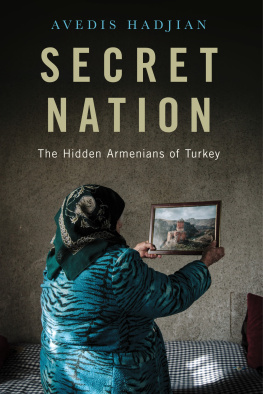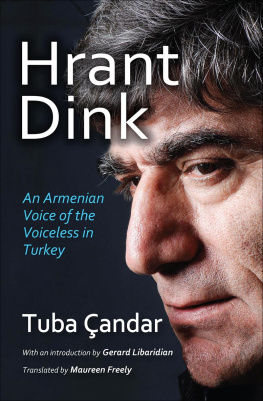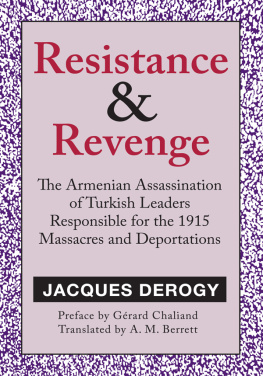Raymond Kvorkian is an historian who teaches at the Institut Franais de Gopolitique, University of Paris-VIII-Saint-Denis. He is Director of the Bibliothque Nubar the Armenian Library in Paris and the author of numerous works on the history of modern and contemporary Armenia and Armenians.
This is a major, magnificent achievement of scholarship. It is hard to imagine this book being surpassed for decades in terms of the breadth and depth of its research and the scale of its undertaking.
Donald Bloxham, Professor of Modern History,
University of Edinburgh
Raymond Kvorkian has made a major contribution to the developing historiography of the Armenian Genocide of 19151916. Using previously little-employed sources found in distant archives, he weaves a detailed and compelling account of the ideological background, the planning and execution of the first major mass killing by a modernizing, nationalizing state. An event of this magnitude, one would believe, could be neither denied nor forgotten, and yet through the systematic efforts of governments of the Republic of Turkey this crime of crimes has been obscured and rendered controversial. Reading this rich, convincing account makes this holocaust before the Holocaust undeniable.
Ronald Grigor Suny, Charles Tilly Collegiate Professor of Social and Political History, University of Michigan, and author of Looking Toward Ararat: Armenia in Modern History
This is the most comprehensive book to date on the Armenian Genocide of 1915. In this detailed account, Raymond Kvorkian describes the process which drove 1.5 million Armenians in the Ottoman Empire to their deaths.
Le Monde
This mighty volume constitutes the most complete summary to date.
Histoforum, Paris

Reprinted and first published in 2011 by I.B.Tauris & Co Ltd
6 Salem Road, London W2 4BU
175 Fifth Avenue, New York NY 10010
www.ibtauris.com
Distributed in the United States and Canada
exclusively by Palgrave Macmillan
175 Fifth Avenue, New York NY 10010
French edition published in September 2006 by Odile Jacob as Le Gnocide des Armniens
Copyright ODILE JACOB, 2006, 2011
The right of Raymond Kvorkian to be identified as the author of this work has been asserted by him in accordance with the Copyright, Designs and Patents Act 1988.
All rights reserved. Except for brief quotations in a review, this book, or any part thereof, may not be reproduced, stored in or introduced into a retrieval system, or transmitted, in any form or by any means, electronic, mechanical, photocopying, recording or otherwise, without the prior written permission of the publisher.
ISBN: 978 1 84885 561 8
eISBN: 978 0 85773 020 6
A full CIP record for this book is available from the British Library
A full CIP record is available from the Library of Congress
Library of Congress Catalog Card Number: available
Introduction
T he destruction of historical groups by states is always the culmination of complex processes that unfold in particular political and social environments most notably, in multiethnic contexts. The translation of genocidal intentions into action is systematically preceded by periods of maturation rooted in diverse experiences, collective failures, frustrations, and virulent antagonisms. It is justified by an ideological construction that envisages the elimination of internal enemies from the social body. Each instance of genocidal violence, however, obeys an internal logic that lends it its singularity. The physical destruction of the Armenian population of the Ottoman Empire has, in its turn, a singular feature: it was conceived as a necessary condition for the construction of a Turkish nation-state the supreme objective of the Young Turks. The two phenomena, in other words, are indissolubly linked: we cannot understand the one if we ignore the other.
The present book is informed by this assumption and its structure depends on it. Destruction as self-construction might have been the slogan adopted by the Committee of Union and Progress (CUP) and that is the guiding thread of this study. In adopting it, I have decided to situate myself at a level of observation that privileges the Young Turk and Armenian elites; I have chosen methodically to examine the internal evolution of these limited circles; I have attempted to assess the reactions of the two groups in crisis situations; and finally, I have studied the nature of the interrelations between the two groups, their points of convergence and divergence, and even their ideological similarities. Thus, it is domestic Ottoman politics, examined from the level of the Empires elites, which serves as the frame of reference for this book and sets its problematic. This point of view distinguishes the present book from previous studies, which are generally organized around the Eastern Question and European interventionism in the Ottoman Empire. I have not felt the need here to evoke the historiographical traditions on the subject, so as perhaps to better distance myself from them. The historiography is, in any case, a complex matter calling for a study of its own, one that would divert us from our main subject.
That said, I have primarily interrogated the institutional, political, social, and even psychological mechanisms that culminated in the destruction of the Ottoman Armenians. In particular, I have sought to mark off the successive phases of the radicalization of Young Turk circles. I have paid special attention to decision-making processes, which are a complex phenomenon if ever there was one.
The debates over ideas within the Young Turk elite and the formation and subsequent radicalization of the Young Turks ideology are here set against the parallel development of the nationalism fostered by the Armenian revolutionary movements. These elites, both when they were in opposition to Sultan Abdlhamids regime and, later, when they were at the head of the state, endlessly discussed the destiny of their common society. I have tried to account for this. Particular attention has been paid to the troubling resemblance between the Armenian and Young Turk elites, both of whom saw themselves as the bearers of a sacred mission saving the nation. The present study accordingly moves back and forth between examinations of the practices of each.
As a lens for the examination of the Young Turk regimes political practices, the April 1909 Cilician massacres have been privileged over every other pre-war event. My choice was dictated by the fact that this violence was a major issue in the dialogue between Turks and Armenians, one that provoked a crisis of confidence. The abundant documentation available on this intermediate period, which affords us insight into phenomena that are harder to discern in later periods, was another reason for my choice.
The geographical problematic is the second frame of reference for the present work. The regional approach, which requires that one descends to the micro-historical level, has never been seriously integrated into a global study. The immensity of the geographical area to be considered, together with its local specificities, makes the task a formidable one that has no doubt intimidated more than one historian. The historical vacuum that prevails in this domain is perhaps also not unrelated to the enormous mass of material that has to be patiently sorted out and worked through in order to establish the facts in the different regions. The bloody nature of the events to be examined may, in turn, have dissuaded some. It is not without apprehension that I have set out on this long adventure myself. But a plunge into the Ottoman provinces is also necessary, in that it alone allows us to draw macro-historical lessons from the strategy pursued by the central authorities and to single out the modifications of it that came about one at a time. A regional approach also authorizes conclusions about the fates of the Armenian conscripts which varied with their native region; it helps us identify the categories of Armenians likely to survive (that is, to be drawn into the Turkish world in formation); it throws a harsh but revealing light on the relationship between executioners and victims and on the reactions that the party-states genocidal policies elicited from both society and especially certain officials; and it brings out the roles played by the administrative, army, political, and paramilitary groups linked to the CUP in the context of the extermination plan. What thus comes into view is a repetitive mechanism that consisted in entrusting the legal side of the process to the agencies of the state (identification of people to arrest, formation of convoys, seizure of property) and the shadowy side to the Special Organization, to whose activities we have paid very close attention. In this vast inventory of the realities that emerged in the Armenian provinces of eastern Anatolia and the Armenian communities of western Anatolia, each regional study contributes something to our understanding of the global process.
Next page






